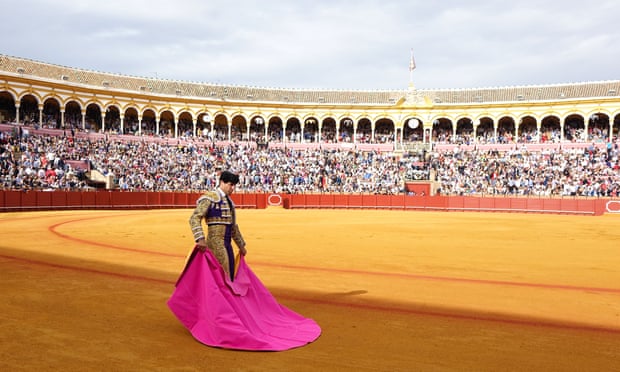It was Spain’s ‘national fiesta’. Now bullfighting divides its people
In the Spanish heartlands, fans and protesters present a portrait of a tradition under threat
“Long Live the Virgin of El Rocío!” Not the first words that would occur to me if I were the recipient of a 25cm abdominal goring that reached my spine – one of the many reasons I’m unlikely to ever have a successful career as a matador.
The last words uttered by Francisco Rivera before receiving medical treatment this August for a potentially fatal injury not only revealed that bullfighting remains inextricably linked with religious iconography, they also illustrated that the ability to face death in both theatrical and stoical terms is crucial to its allure and romance.
In technical terms Rivera has never been a first-class torero, but this isn’t a necessary or sufficient condition for success. At the age of 10, the grandson of Antonio Ordóñez – idolised by Ernest Hemingway in The Dangerous Summer – lost his father to a bull in 1984. Rivera Sr, popularly known as Paquirri, was confirmed a martyr and a saint as video footage circulated of a brave bullfighter bleeding to death and, at the same time, comforting a visibly panicked and unprepared surgeon.
Although vastly improved medical facilities have reduced fatalities, 2015 has been an unusually bloody year in human terms: as well as 13 fatalities in encierros(running with the bulls), several matadors endured life- and career-threatening injuries in the ring.
For the first time in the modern age, the survival of what was once referred to as Spain’s national fiesta is also in jeopardy. Animal rights activists have found an audience among a significant proportion of the population who increasingly view bullfighting as a financial drain at a time of economic crisis, and a symbol of the nation’s ills: cruel, parasitical and out of touch with reality. A profession with deep-seated internal divisions finds itself ill-equipped to defend itself against a concerted opposition and a rapid change in public mood. Funding cuts have put the future of training schools under threat; controversial new plans by the rightwing Popular party government’s Ministry of Education to safeguard their financial viability by incorporating bullfighting into vocational training courses are meeting fierce opposition.
Ángeles González-Sinde, former-minister of culture (2009-11) for the socialist PSOE, told me that young people who came of age in the early 1980s, in the aftermath of Franco’s death, often enjoyed going to watch the bulls, and that there was a strong admiration and affiliation with certain leading toreros who mixed with leading lights of La Movida, the drug-fuelled youth movement that put Pedro Almodóvar and his adopted city of Madrid on the international map. She believes this connection has been lost, and that teenagers now see bullfighting as something alien to their increasingly globalised culture.
When I was at the Sonorama indie music festival this summer I had to go alone to a bullfight as none of my extended group wanted to accompany me. By contrast, two weeks later I found myself at a private beach club in Sotogrande – generally frequented by ageing politicians, property tycoons, bankers and a diverse cast of players from the world of polo – and found the room where bullfights are broadcast on Canal+ to be a popular hotspot.
The retired monarch, Juan Carlos, is a fierce advocate of the bulls (his son, Felipe VI, has retained a diplomatic silence), but this is of limited use to proponents of bullfighting when his standing in public opinion is at an all-time low. Images of the emeritus king in San Sebastián to celebrate the return of the bulls after three years did little to dispel ingrained prejudices about aficionados as cigar-smoking reactionary figures from an older generation.
The overturning of a prior prohibition in the Basque coastal city was the result of a change in municipal rule; in fact, it is impossible to understand the debates surrounding bullfighting without taking into account the territorial and political reality of a nation state comprising 17 autonomous regions, with more than 8,000 mayors.
Having been prohibited for many years in the Canary Islands, the 2011 ban in Catalonia fed into independence debates, evidence for nationalists of their distinction from the centralist state. This approach sidelined the tradition of bullfighting in and around Barcelona, while the dismissal of a cultural activity as the manifestation of a conservative Spanish heartland fails to mention that it continues to be practiced in much of southern France.
José Tomás, the world’s leading bullfighter, made a conscious decision to stage his comeback to a sold-out crowd in the Catalan capital in 2007; his 2012 solo performance in Nîmes with six bulls – the standard, although by no means unique, format is for the contemporary bullfight is for three toreros to take on two bulls each – is considered the finest corrida of the modern age.
While the unpredictability of an event that depends as much on an animal as a human being is crucial to the frisson of live performance, the communion between a torero, bull and audience rarely achieves the degree of synchronicity to satisfy the purist’s definition of art. This is a serious obstacle for the casual attendee, especially when decent tickets generally cost upwards of €50 (£36). Hence the appeal of flamboyant showmen and celebrity toreros, who prove particularly popular in provincial bullrings, and frequently as part of the festivities associated with the patron saint of a local village or small town.
In terms of pure entertainment, Juan José Padilla, replete with his now trademark eyepatch – the result of a near-fatal goring in 2011 – and pirate paraphernalia is difficult to beat, at least until one becomes (over-) familiar with some of his trademark tricks. I watched Morante de la Puebla, many aficionados’ matador of choice, booed for an under-par performance with a bull in Antequera last summer; the audience was more indulgent of a chaotic display by El Pana, a septuagenarian Mexican who smokes a cigar before taking his sword. The maverick, undeterred by the fact it took him six inelegant and cruel attempts to kill his second bull, lapped the ring at an ever-increasing speed, whipping the crowd into a frenzy as if he had just delivered a masterful pièce de résistance.
The sanctity of the ritual has also been disrupted repeatedly this year by protesters jumping over the barrier to interrupt the matador’s performance. Peter Janssen has been particularly active in this regard. In August this Dutch national jumped into a ring alongside a fellow protester in Marbella during an appearance by Morante, who subsequently refused to kill the second bull in protest against the police chastising his team for manhandling the intruders; the bullfighter has also taken legal action against activists for calling him a murderer.
The pro-bullfighting lobby often accuse their critics of anthropomorphism – the attribution of human qualities to animals – although they are hardly immune from this tendency. Fighting bulls always have names, and commentators on Canal+ have been known to talk of how an under-performing animal is “lucky” to have a skilled torero able to bring out their best qualities.
Popular chants and slogans on demonstrations include “Bullfights, the animal Guantánamo”, “Bullfighting, shame of the nation” and “Torture is not culture”. The bigger and more troubling question is: does bullfighting’s cultural status justify its continued existence? Federico García Lorca and Pablo Picasso were great aficionados, and individuals who would normally be considered civilised continue to take great pleasure in the act of watching a man face a potentially deadly animal. Reared on processed meat, Anglo-American audiences increasingly have little direct contact with the harsh realities of nature and often lack a sensibility or vocabulary with which to discuss or dissect death. But perhaps the strongest argument against bullfighting is that aestheticisation can distract from the reality of what is taking place. The moral challenge is to resist simplistic rejection without lapsing into a pastiche of Hemingway.
Duncan Wheeler is associate professor in Spanish Studies at the University of Leeds, and Visiting Fellow of St Catherine’s College, Oxford. His book, The Cultural Politics of Spain’s Transition to Democracy, will be published next year by Bloomsbury






No comments:
Post a Comment
Please leave a comment-- or suggestions, particularly of topics and places you'd like to see covered